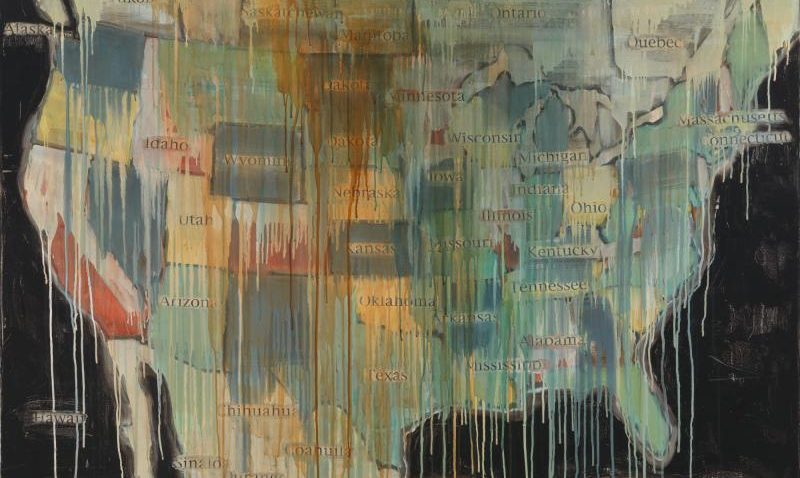 Reflecting on this past Wednesday’s virtual visit with Phoebe Hillemann and Elizabeth Dale-Deines, while our discussion was cut a bit short due to time/some of our questions had to be answered via email, this introduction to SAAM plus the mini “exhibit curation” activity we did was educational and fun regardless. At the beginning of the virtual meeting, we all introduced ourselves via zoom chat. Hillemann then proceeded to jump right into a presentation she had created, giving us additional knowledge about SAAM that I did not include in my pre-presentation. For example, as I had stated in my introductory video/blog post for the Smithsonian American Art Museum, this collection was started long before the Smithsonian was even established.
Reflecting on this past Wednesday’s virtual visit with Phoebe Hillemann and Elizabeth Dale-Deines, while our discussion was cut a bit short due to time/some of our questions had to be answered via email, this introduction to SAAM plus the mini “exhibit curation” activity we did was educational and fun regardless. At the beginning of the virtual meeting, we all introduced ourselves via zoom chat. Hillemann then proceeded to jump right into a presentation she had created, giving us additional knowledge about SAAM that I did not include in my pre-presentation. For example, as I had stated in my introductory video/blog post for the Smithsonian American Art Museum, this collection was started long before the Smithsonian was even established.
Following Hilleman’s informative presentation, Elizabeth Dale-Deines, another Teacher Programs Coordinator at SAAM, led us all in a group activity that involved categorizing 6 artworks she had provided & connecting them with themes– these such themes included immigration the diversity of America, the under-representation of race (such as in painted portraits), consumerism, industrialization, and capitalism. This activity, which consisted of us taking a pairing of artworks and connecting both of them with capitalistic themes, was very invigorating & thought-provoking. I didn’t expect a group activity during our virtual visit, however, I enjoyed it regardless.
Looking into Phoebe Hillemann and Elizabeth Dale-Deines’ career paths and comparing them with other institution employees’ career paths; Elizabeth’s was similar to others that we had observed in this course, they were less straightforward and more zigzagged. However, in Phoebe Hillemann’s case, she was able to go from her schooling to her desired career in a more direct path than other employees within the arts that we had interviewed. This surprised me, as the directness of her career path is what many people hope to accomplish right after their schooling. However, despite this want for a direct schooling to dream career line, the reality is that many careers involving the arts tend to zigzag before ending up at a high institutional job such as a branch of the Smithsonian, SAAM. This piece of knowledge is both comforting and stressful, as I hope to work in a position involving the arts (maybe museum curation?) someday.
Focusing on our class’s theme of “Democracy and the Arts,” I asked both Hillemann and Dale-Deines what they thought about the link between democracy & the arts, along with how federal versus private funding impacts exhibitions:
Alexa (myself): What do you two think about the link between democracy & the arts: do they need each other, or can only one exist independently? Additionally, have you noticed if there have been any negative implications from being partly government-funded (for example, being unable to display certain exhibits)? Or has the private funding allowed these exhibits?
Elizabeth: I think art can exist outside of democracy (artists have created works under all kinds of dictatorships, oligarchies, etc.). I think that within a democracy, particularly one that prizes free speech, art will likely flourish, diverge, and spark conversation. I think art can also be a tool of and for democracy.
Phoebe: I agree. [In the case of] negative implications of government funding for exhibit content, there have been some notable cases in Smithsonian history when this has caused controversy and even censorship. It is important and helpful for the public (and the press) to speak out against censorship in these instances! These extreme examples are rare (and I’d like to think the Institution would handle them differently today) but the intersection of politics and government-funded museums means that we do have to keep in mind what topics could be controversial and be prepared with strong scholarship and ways of responding to potential challenges.
Comparing Hillemann & Dale-Deines’ responses to previous institutions’, I was pleasantly surprised. In the past, some of the employees who worked in the arts that we interviewed had expressed that they tried to remain “politically neutral,” which I personally found kind of bizarre. It’s hard to be “politically neutral” in these times, during a global pandemic & times of racial and economic injustice.
Overall, I was very grateful to learn about a branch of the Smithsonian (SAAM) more in-depth from two of their teacher institute educators, and I especially enjoyed the mini curation exercise. SAAM doesn’t avoid politics within its exhibits and hopes to connect with the public in order to speak out about potential censorship despite being partially federally funded. After my whole experience presenting upon this institution & attending a virtual visit, I hope sometime during the next few years I can actually travel to SAAM & see some of their exhibits in person!
